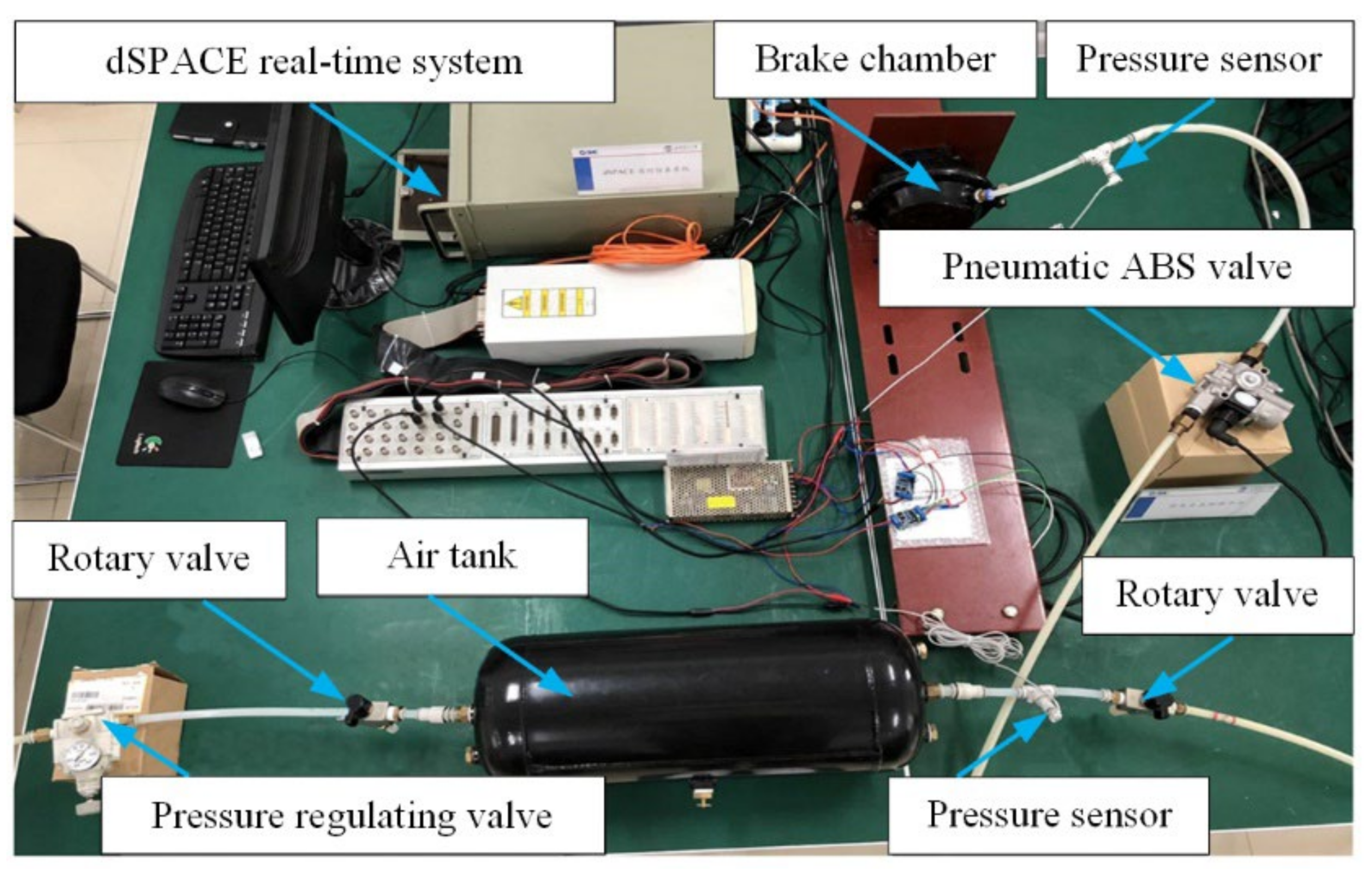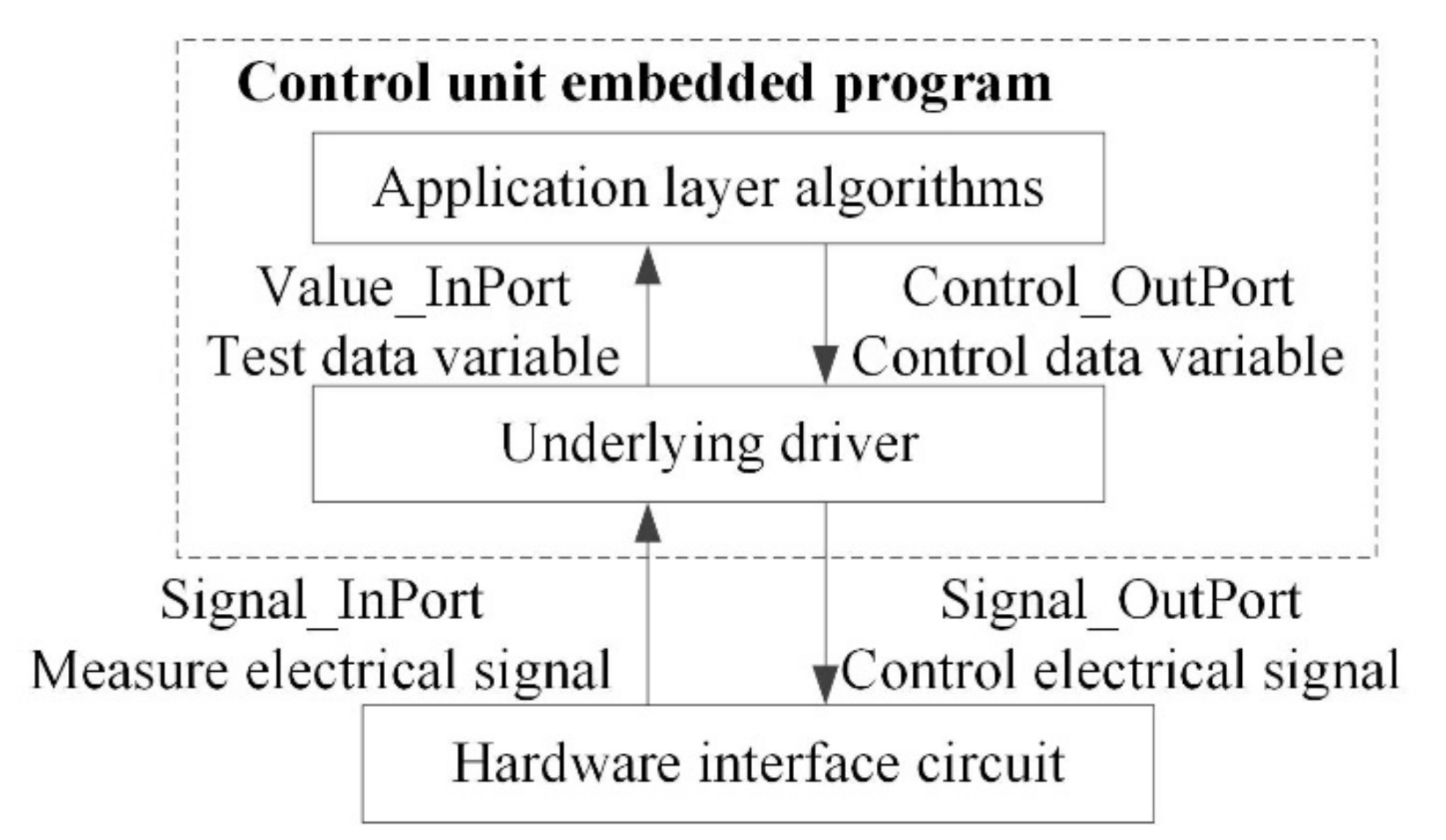An End-of-Line Test System for Pneumatic ABS Controllers in Commercial Vehicles
Abstract
:1. Introduction
2. EOL Test Scheme Establishment
3. Wheel Speed Simulation
3.1. Wheel Speed Simulation Model
3.2. Configuration of Vehicle Parameters and Test Conditions
3.3. Analysis of Simulation Results
4. Development and Functional Verification of EOL Test System
4.1. Hardware Design
4.2. Development of Embedded Program
4.3. Prototype Construction
4.4. Multi-Condition EOL Test and Verification
5. Discussion
6. Conclusions
Author Contributions
Funding
Conflicts of Interest
References
- Hao, R.; Zhao, X.; Zhou, Z. Bench Detection and Road Comparison Test for Auto Anti-lock Braking System. Trans. Chin. Soc. Agric. Mach. 2013, 44, 21–26. [Google Scholar]
- Xu, J.; Li, W.; Dong, J.; Zhai, J. Design of a hardware-in-loop test bench for air ABS. Res. Explor. Lab. 2017, 36, 90–93. [Google Scholar]
- Zhang, W.; Ding, N.; Chen, M.; Yu, G.; Xu, X. Development of a Low-cost Hardware-in-the-loop Simulation System as a Test Bench for Anti-lock Braking System. Chin. J. Mech. Eng. 2011, 24, 98–104. [Google Scholar] [CrossRef]
- Xiong, Y.; Li, X.; He, Y.; Wu, M.; Long, Y. Design and application of testing system for pneumatic ABS ECU. In Proceedings of the 11th World Congress on Intelligent Control and Automation, Shenyang, China, 29 June–4 July 2014; pp. 3612–3617. [Google Scholar]
- Zheng, H.Y.; Zong, C.F.; Zhao, W.Q.; Chen, L. HILS Test Bench Based on Open and close Loop Test for Air ABS System. In Advanced Materials Research; Trans Tech Publications: Freienbach, Switzerland, 2013; pp. 1484–1487. [Google Scholar]
- Shen, C.Y. Development of HIL Test Bench for Pneumatic ABS and Vehicle Attitude Warning Device. Master’s Thesis, Jilin University, Jilin, China, 2012. [Google Scholar]
- Yang, S.C. Research on Test and Evaluation Method of Pneumatic ABS System Based on HIL. Master’s Thesis, Jilin University, Jilin, China, 2015. [Google Scholar]
- Montani, M.; Vitaliti, D.; Capitani, R.; Annicchiarico, C. Performance Review of Three Car Integrated ABS Types: Development of a Tire Independent Wheel Speed Control. Energies 2020, 13, 6183. [Google Scholar] [CrossRef]
- Chu, L.; Hou, Y.; Liu, M.; Li, J.; Gao, Y.; Ehsani, M. Development of air-ABS-HIL-simulation test bench. In Proceedings of the 2007 IEEE Vehicle Power and Propulsion Conference, Arlington, TX, USA, 9–12 September 2007; pp. 691–695. [Google Scholar]
- IEEE24765; ISO/IEC/IEEE International standard systems and software engineering—Vocabulary. C/S2ESC—Software & Systems Engineering Standards Committee: Geneva, Switzerland, 2017.
- ISO26262; Automotive safety integrity level. International Organization for Standardization: Geneva, Switzerland, 2011.
- Merayo, M.G.; Núñez, A. Passive testing of communicating systems with timeouts. Inf. Softw. Technol. 2015, 64, 19–35. [Google Scholar] [CrossRef]
- Che, X.; Maag, S. Passive performance testing of network protocols. Comput. Commun. 2014, 51, 36–47. [Google Scholar] [CrossRef]
- Pacejka, H.; Besselink, I. Magic formula tyre model with transient properties. Veh. Syst. Dyn. 1997, 27, 234–249. [Google Scholar] [CrossRef]
- Ding, F. Decision, Complexity, convergence and computational efficiency for system identification algorithms. Control 2016, 31, 1729–1741. [Google Scholar]
- Li, J.; Li, Y.; Wen, G. Design of automobile control system based on automatic code generation technology. Electron. Des. Eng. 2019, 27, 166–169. [Google Scholar]
- Liu, Y.; Li, Y.Q.; Zhuang, R.K. The application of automatic code generation technology in the development of the automotive electronics software. In Applied Mechanics and Materials; Trans Tech Publications: Freienbach, Switzerland, 2013; pp. 1574–1577. [Google Scholar]
- Wang, L.; Zhang, Y.; Yin, C.; Zhang, H.; Wang, C. Hardware-in-the-loop simulation for the design and verification of the control system of a series–parallel hybrid electric city-bus. Simul. Model. Pract. 2012, 25, 148–162. [Google Scholar] [CrossRef]
- Hu, Z.; Shi, T. The design and implementation of motor control system monitoring software based on WPF. Hans J. Wirel. Commun. 2016, 6, 1–9. [Google Scholar] [CrossRef]











| No. | Test Conditions | Conditions Description |
|---|---|---|
| 1 | Straight-line braking test on single road | Braking test on high-adhesion or low-adhesion road |
| 2 | Adaptive test on bisectional road | Braking test on both sides of high-adhesion and low-adhesion road |
| 3 | Adaptive test on joint road | Braking test when driving from high-adhesion to low-adhesion road |
| Coefficient | T1 | T2 | T3 | T4 | T5 | T6 | T7 | T8 | T9 |
|---|---|---|---|---|---|---|---|---|---|
| Value | −3.93 × 10−6 | 0.907 | 164 | −5.43 × 10−5 | 12.5 | 1.12 | 0.695 | 2.14 × 10−6 | 0.396 |
| Parameter | Value |
|---|---|
| Gross mass m/kg | 11,380 |
| Centroid height h/m | 1.35 |
| Distance from center of mass to front axle lf/m | 4.20 |
| Distance from center of mass to rear axle lr/m | 3.10 |
| Effective radius of the wheel R/m | 0.48 |
| Moment of inertia of the wheel J/(N · rad−1) | 43.2 |
| Maximum pressure of the braking system /Pa | 6.5 × 105 |
| Test Conditions | Initial Brake Speed v0/(km · h−1) | Adhesion Coefficient of High-Adhesion Road μH | Adhesion Coefficient of Low-Adhesion Road μL |
|---|---|---|---|
| Straight-line braking test on single road | 80 | 0.8 | - |
| 60 | - | 0.3 | |
| Adaptive test on bisectional road | 80 | 0.8 | 0.3 |
| Adaptive test on joint road | 80 | 0.8 | 0.3 |
| Traceability Code | Controller Type | Initial Fault | Expected Fault Code |
|---|---|---|---|
| 1PSP000010325 | Biaxial 24 V | Fault-free | 0x00 |
| 1TVC142973201 | Three-axis 24 V | Fault-free | 0x00 |
| 4967327673671 | Biaxial 24 V | Wheel speed signal processing unit failure | 0x05 |
| 6936281408300 | Biaxial 12 V | Fault-free | 0x00 |
| 6955141301278 | Biaxial 24 V | Communication unit failure | 0x01 |
| 9D11337278341 | Biaxial 24 V | ABS indicator control unit failure | 0x02 |
| Q300076767276 | Biaxial 12 V | ABS valve drive unit failure | 0x03 |
| X972507312734 | Biaxial 24 V | ABS function switch unit failure | 0x04 |
| No. | Test Time/h | Test Quantity | No. | Test Time/h | Test Quantity |
|---|---|---|---|---|---|
| 1 | 4 | 953 | 4 | 4 | 959 |
| 2 | 4 | 958 | 5 | 4 | 956 |
| 3 | 4 | 955 | 6 | 4 | 961 |
Publisher’s Note: MDPI stays neutral with regard to jurisdictional claims in published maps and institutional affiliations. |
© 2022 by the authors. Licensee MDPI, Basel, Switzerland. This article is an open access article distributed under the terms and conditions of the Creative Commons Attribution (CC BY) license (https://creativecommons.org/licenses/by/4.0/).
Share and Cite
Xu, J.; Xiang, Q.; Li, G. An End-of-Line Test System for Pneumatic ABS Controllers in Commercial Vehicles. Appl. Sci. 2022, 12, 4435. https://doi.org/10.3390/app12094435
Xu J, Xiang Q, Li G. An End-of-Line Test System for Pneumatic ABS Controllers in Commercial Vehicles. Applied Sciences. 2022; 12(9):4435. https://doi.org/10.3390/app12094435
Chicago/Turabian StyleXu, Jun, Qian Xiang, and Gangyan Li. 2022. "An End-of-Line Test System for Pneumatic ABS Controllers in Commercial Vehicles" Applied Sciences 12, no. 9: 4435. https://doi.org/10.3390/app12094435
APA StyleXu, J., Xiang, Q., & Li, G. (2022). An End-of-Line Test System for Pneumatic ABS Controllers in Commercial Vehicles. Applied Sciences, 12(9), 4435. https://doi.org/10.3390/app12094435







